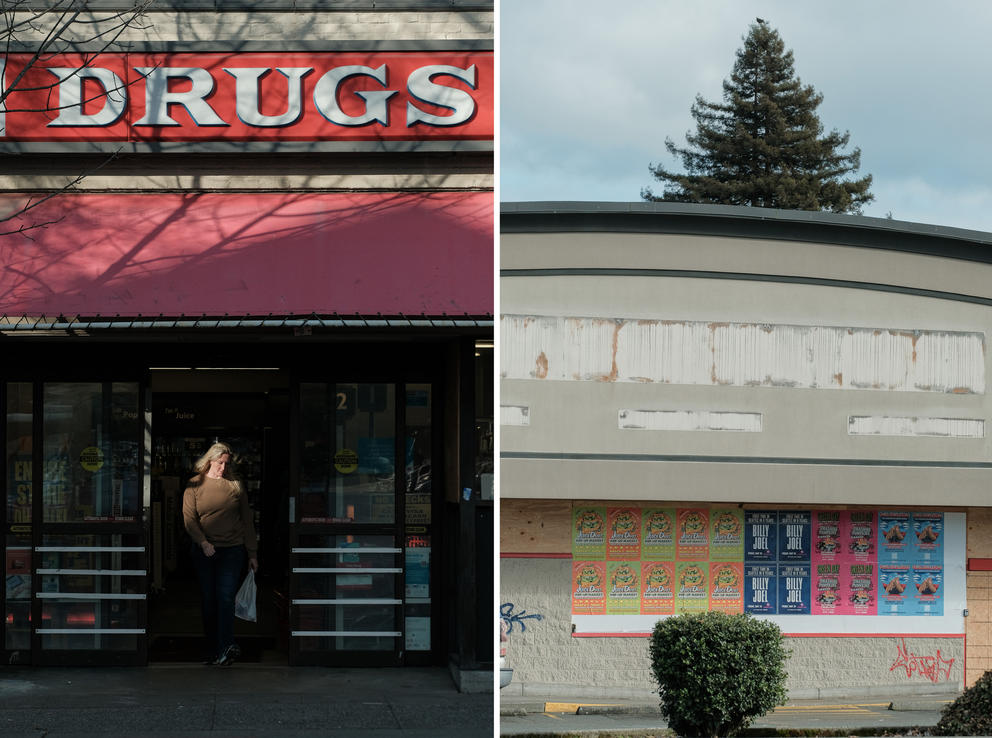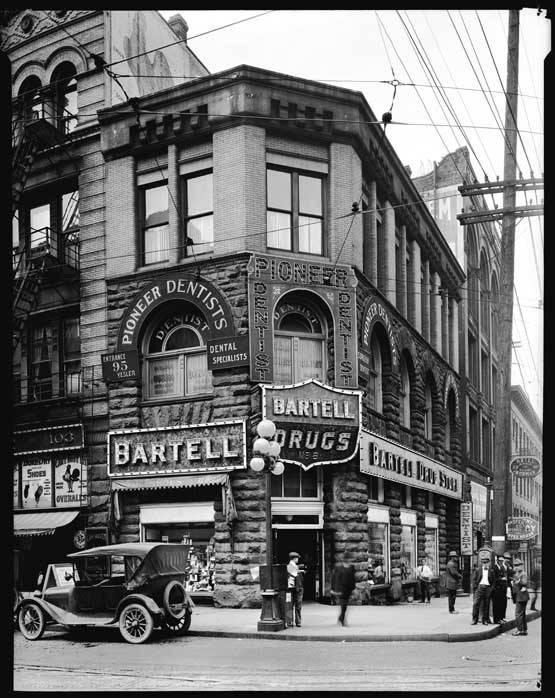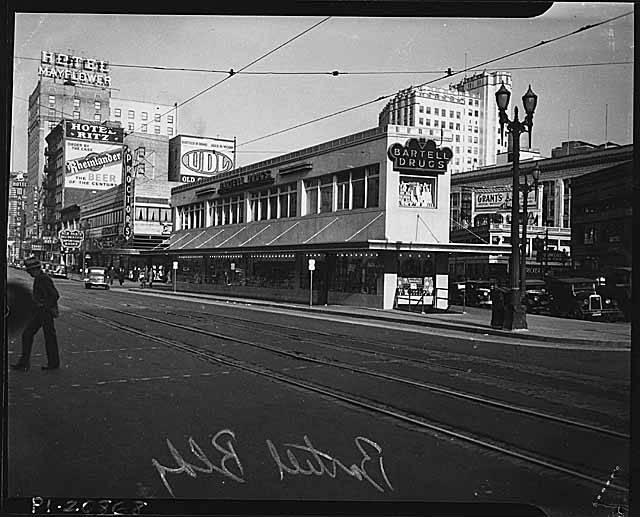To me, and to so many other longtime Seattle residents, Bartell Drugs — which locals only call Bartell’s — has been more than just a drugstore. It is part of the fabric of Seattle.
As a local chain that specializes in products made in the Northwest, it has long been my go-to location for Erin’s Popcorn, La Panzanella crackers, and the occasional antibiotic. The crimson ink in the once ubiquitous Bartell’s newspaper circulars remains cemented in my memory.
Even when bigger chains like CVS or Walgreens moved into neighborhoods I lived in, sometimes offering cheaper prices, I continued to shop at Bartell’s, and so did virtually everyone I know. Supporting Bartell’s — a family-owned Seattle-based chain that started in 1890, only a year after Washington became a state — felt like part of the civic responsibility of living in Seattle.
There was something essentially “Seattle” about the buying experience at Bartell’s —even if only a pack of gum. They kept their shelving low so you could see all through the store, unlike other chains that packed as much stuff as they could into tall aisles (presumably for higher profits per square inch). And Bartell’s staff were trained to be extraordinarily friendly. Like the title of Ernest Hemingway’s 1933 short story, Bartell’s was a “clean, well-lighted place,” and for many years it embodied old-school Seattle to me.
But in 2020, Rite Aid, one of the three biggest pharmacy chains in the U.S., bought all 67 locations of Bartell Drugs. Rite Aid paid just $95 million, a figure that some analysts said was surprisingly low, given the real estate imprint of Bartell’s in a pricey region.
Both Bartell and Rite Aid brass issued press releases upon the sale announcing that everything would stay exactly the same, and maybe better. That press release was headlined: “Historic Brand Remains in Place; Deal Expands Health and Wellness Approach in Seattle and Puget Sound Region.” In a subsequent story about the merger in The Seattle Times, Bartell’s senior vice president of operations Ken Mahoney said, “Rite Aid is completely committed to keeping Bartell’s Bartell’s.”
It didn’t work out that way.
Rite Aid quickly closed many locations, leaving longtime customers howling online. Even worse were problems with prescriptions at stores that did stay open. Many customers reported prescriptions delayed, or lost, or backed up with massive lines when Rite Aid moved Bartell’s to their computer software.
Charles Tomaras was one of those customers with prescription problems. His partner was suffering from terminal cancer at the time, and Bartell’s had been supplying life-prolonging drugs. “When they switched to Rite Aid’s computer system, all of your previous medication history went away,” Tomaras told me. “There were massive lines at the counter, and the chief pharmacist, at the store I’d gone to for 23 years, quit. It was a complete mess.”
Things have continued to devolve. In October 2023, Rite Aid itself filed for bankruptcy to deal with massive debts and liabilities from ongoing opioid-related lawsuits. Then Rite Aid announced more closures of both Rite Aid and Bartell’s locations.
“When Rite Aid originally bought Bartell’s, my first concern was whether they would turn the locations into Rite Aids, but soon it became a worry that your local store under any name would close for good,” said Tomaras.
When Rite Aid purchased Bartell’s there were 67 Bartell stores. Currently, as best as I can tell, there are 44 still open in the Puget Sound area, but a couple of those are having going-out-of-business sales, including the popular Wallingford Bartell’s on 45th Street.
I write “best as I can tell” because despite spending $95 million to buy Bartell’s, no one at Rite Aid has ever updated the home page of Bartell’s website to reflect store closures. As of the middle of February 2024, that site still touts how “innovation” allowed founder George Bartell and his heirs to “successfully grow and shape the business to the 67 stores and pharmacy locations it is today.”
The URL for Bartell’s itself also lists the number of stores at 67. Any 15-year-old with minor coding skills could update this, but Bartell’s — under Rite Aid — is still advertising and bragging about their closed “ghost” stores.
One of Seattle’s oldest stores
Bartell Drugs started in 1890 with one store in Seattle’s Central District, at 27th Avenue South and South Jackson Street in Leschi, and grew from there. For decades, the flagship store sat at the center of downtown Seattle, between Fourth and Fifth and Pike and Pine.
George H. Bartell started his first drugstore on Jackson Street in 1890, shortly after Seattle’s great fire. By the end of 1921, he had a chain of eight drugstores in various parts of the city. This photo, probably taken in 1921, shows a new Bartell drugstore at the corner of First Avenue and Yesler Way. (Courtesy of MOHAI, 1983.10.2144)
That triangle-shaped Bartell’s opened in 1937 and was pictured on countless postcards from the era as the very representation of Seattle as a modern city. There was a tearoom on the top floor and a sandwich counter on the bottom.
Decades before Starbucks embraced its mission of being a “third place” — a social environment where people interact outside of home and work — the downtown Bartell’s was already serving as exactly that.When the Monorail was constructed in the 1960s, it dropped people off directly in front of Bartell’s.
For people who grew up in Seattle in the postwar era, the triangle store became slang for Downtown. “If you were meeting someone downtown,” said actor Matt Smith, “you almost always met at Bartell’s. The only other choices were Woolworth’s or the Pike Place Market.”
Smith, 71 and born and raised on Capitol Hill, said that Bartell’s lunch counter, complete with a traditional soda fountain, was the ultimate mixing room for Seattle people of all genders, races and economic groups. “Everybody could afford a Coke at Bartell’s,” he said. “Bartell’s was a melting pot for Seattle.”
That location closed in 1984 for the construction of Westlake Center, and it could be argued that downtown Seattle has never quite been the same. There was order, safety, community and a certain properness to the Bartell’s lunch counter that Westlake Center never recreated.
Bartell’s opened a new store on the corner of Fifth and Olive and renamed it “Bartell’s #1,” but without the food service it wasn’t the same. In December 2023, #1 also closed, leaving no Bartell locations left in downtown Seattle.
The nostalgia that Seattle residents feel for Bartell’s seems directly proportional to how long they’ve lived in the city. I came here in the late 1970s from Pullman to attend the University of Washington. On my first day in Seattle, I went to the Bartell’s on University Avenue and bought shampoo, a hair dryer and a hairbrush — I still brush my hair with that same brush.
There also was a Rite Aid on the Ave back then, and I remember once heading toward it with my college friends, including John Keister — later the host of local television show Almost Live. Keister stopped me.
“Hey, you live in Seattle now,” he instructed. “People in Seattle go to Bartell’s, and only go to Rite Aid if Bartell’s is out of something.” Keister gave a long primer on proper Seattle etiquette, and how supporting locally based businesses was “the way Seattle does things.” I quickly got with the rules in my adopted hometown.
Recently, over the phone, Keister elaborated on his youthful advice: “There were these key institutions in Seattle. They were all part of the Seattle ethic. You could go to these places with such confidence they would fix whatever problem you had. They included Dick’s, REI, Ivar’s, Bartell’s and Nordstrom’s. Oftentimes, they had been started or run by people of Scandinavian or Asian ancestry, and there was always this concept in those cultures that ‘We’re going to do things right.’ This was part of ‘the Seattle way.’”
Keister mentioned Nordstrom’s a few times in our talk — like me, he always calls it Nordstrom’s with a possessive “s” rather than its official name. It hit me that this use of the possessive may reflect something about customer loyalty, so I reached out to Pete Nordstrom, president of Nordstrom, for his thoughts on that and whether there was a “Seattle way” of doing business.
“There has always been a strong sense of pride being associated with Seattle,” Nordstrom said. “If my dad were speaking to you about it, he would talk about Bartell’s, Ivar’s, Boeing, Ben Bridge, etc., as setting a high standard for both customer service and business success, as well as being good community citizens. Those were founder-led stores where clearly there was a commitment and a passion.
“To this day,” he continued, “we talk about creating a culture with one of our values being ‘owners at heart,’ and having a personal interest and stake in the business creates better outcomes.”
Nordstrom’s corporate mission statement sums it up as, “Shopping changes. Our commitment to happy customers doesn’t.” I suspect this is not something you’d find on the corporate mission statement of many Wall Street hedge funds, or at Rite Aid or CVS.
I asked Pete Nordstrom if he thought locals calling his stores “Nordstrom’s” reflected a familial relationship in the punctuation choice. “I’ve never really thought of it as some kind of term of endearment,” he laughed, “but I can see that, so maybe it shouldn’t bug me.” Nordstrom said the added possessive bothered him mostly because of the many times he’s been called “Pete Nordstroms.”
Bartell’s and Nordstrom’s weren’t the only local businesses to find their names adapted by loyal locals. Citizens of a certain generation still call the Boeing Airplane Company “Boeing’s.”
Chocolates, condoms and Cotlets
Keister told me he has always been particularly fond of Bartell’s supply of candy and their support of Northwest companies like Brown and Haley, Theo’s Chocolate, and Liberty Orchards, who make Aplets and Cotlets. “They’ve got stuff that no one else carries,” he said. “I was in this different store once, and asked if they had Corn Huskers Lotion, and they looked at me like I was crazy. Bartell’s has always carried what people in the Northwest liked. It was just the way they did business.”
The Bartell’s on the Ave — the one Keister and I frequented in our youth — closed last spring. I hadn’t heard about the coming closure, but I ended up walking by the day after it had been shuttered. The fixtures were still in place, including the “We’re Loving Local” sign that hung at the front, highlighting Bartell’s commitment to Northwest companies.
This Bartell’s, at the corner of Northeast 45th Street and University Way, held a hint of Seattle music history. One of Nirvana’s early managers lived above the store, and the band often stayed there when in Seattle. Did Kurt Cobain buy contraception at that corner Bartell’s, like I did when I was in college?
We’ll never know, but another link to local music is more certain. In November 2020, at the height of COVID closures, Bartell’s launched a Keep Music Live line of hats, sweatshirts and face masks, with 50% of proceeds dedicated to helping struggling local music venues. I would be highly surprised next pandemic if Rite Aid would do the same.
Before Rite Aid purchased Bartell’s, it was the oldest independently owned drugstore chain in the nation. The absorption of Bartell’s reflects homogenization that isn’t unique to Seattle, or to drugstores, or to this decade. But corporate America’s appetite for the drug industry has been enormous. (Amazon wants a piece of it, too, and in 2018 bought PillPack, now called Amazon Pharmacy.) A recent McKinsey report noted that the number of independent retail pharmacies had decreased by 50 percent since 1980, and that more consolidation is certain.
To better understand the relationship customers have with their pharmacy, I reached out to Todd Ramsey, who for 34 years owned the independent Ostrom’s Drug and Gift in Kenmore. Ostrom’s is so homey it is far closer to what George Bartell started in 1890 than any present-day Walgreens.
“There’s a special relationship people, particularly people who take a lot of medicine, have with their pharmacist,” Ramsey said. “For many, their pharmacist ends up as a confidant, and as a friend.”
Ramsey admired the way Bartell’s handled their relationships with customers. “Bartell’s were great, and maintained that personal flavor, and ran a really good business.” Like other independent pharmacies, Ramsey was approached over the years by many chains, including Rite Aid. But he says there is a “Seattle way” of doing business. “I have a general sense that people in Seattle are more honest, and know to do the right thing,” Ramsey said.
When Ramsey recently decided to sell Ostrom’s and retire, he had plenty of chains to pick from. But he sold to a buyer who would keep his store independent “for the sake of the customers and the employees,” he said. It will come as no surprise that Ramsey has always lived in Seattle — he gets Seattle.
Bargain Converse and local popcorn
No one knows how many Bartell’s will be left as Rite Aid moves through bankruptcy. I recently visited a few of the 40-something stores remaining, and they were packed because — and this may still come as a surprise to Rite Aid executives — people in Seattle love Bartell’s.
Those who find joy in the endcaps featuring Fisher Fair Scone mix, or Snoqualmie Falls Lodge Oatmeal, or Erin’s Popcorn, can still go to plenty of Bartell’s with a little searching. Even at the one in Wallingford — with its “going out of business” banners everywhere — I found the employees maintaining Bartell’s-level friendliness despite the signs of doom around them.
If it sounds a bit crazy and nostalgic to say that I’d gladly position myself to be the last Bartell’s customer, do know that I’ve done this before. When I heard iconic Seattle chain Chubby & Tubby was closing their Aurora store in 2003, I rushed over, and by happenstance was one of the last people to check out.
In Chubby & Tubby’s final hour, you could fill a shopping cart with what was left on the shelves and pay just $20. I had a 3-year-old then, so I shoved all the remaining stock of Converse All-Stars into my cart. For the next 15 years, my son’s footwear came from that one cart. The bargain was nice, but what was priceless was the fact that my son could tell kids in high school that his Cons, some with mismatched colors, had come from a long-gone but forever-beloved Seattle institution (one, sadly, that most kids of his generation had no knowledge of).
It probably won’t feel the same if I stock up on MarketSpice Tea at the last Bartell’s. Most things Bartell’s sells I can find elsewhere or online, but online sales don’t come with a smile from the person behind the counter — much less a sense of pride in local history. But many current Seattle dwellers no longer appear to care about the city’s traditions or supporting local businesses.
As for Charlie Tomaras, who had trouble getting medications at Bartell’s for his dying partner, he eventually left Bartell’s. “It pained me,” Tomaras said. “My dad had loved Bartell’s, so my family had gone for decades. He just loved going there and seeing whatever interesting things they had on the endcaps, whether it was scone mix or stewed tomatoes. It was just the kind of thing you did in Seattle. But I had a partner who was dying and couldn’t get her meds, so I switched pharmacies.”
Tomaras moved his prescriptions to Walgreens, where things were improved. Sadly, his partner died, but Tomaras continued using Walgreens. “Then the Walgreens I was going to also closed,” he said. “Now I’m transferred to another Walgreens. I’m not sure when it’s going to end.”
No one knows if or when Bartell’s will come to an end. It’s possible that Rite Aid stores will close and some remaining Bartell’s will survive in Seattle, but somehow I suspect not. And there is real loss in losing a store that started not long after the Civil War, and that was often located in disenfranchised communities where access to prescriptions will be harder to come by with Bartell’s gone. But all over the world, we’ve gone from enjoying a distinct “third place” to a “work from home” situation with just one place — sitting in front of a screen and experiencing all life has to offer, including drugstore shopping — from the same seat.
There are still those few dozen stores left, so I’ll support them while I can. But if news goes out that there’s only one Bartell’s standing, and it’s closing time, I’ll dutifully rush out to buy their last bags of Erin’s Popcorn and appreciate that Bartell’s red color scheme one more time. That’s just what you do as a longtime Seattleite.










